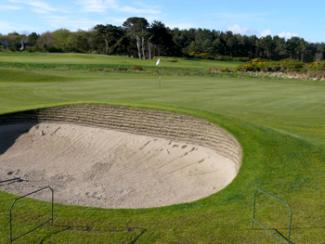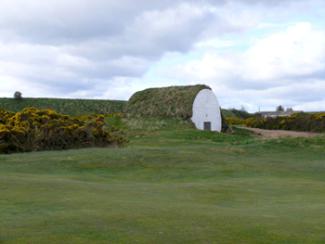Featured Golf News
Crossing Scotland, Day 8 - Nairn & the Boat of Garten
While Castle Stuart was a gathering of international players, our next stop, Nairn Golf Club, is more of a member's course with outside players welcomed and tolerated.

Looking across Nairn Golf Club
Nairn is a wonderful course, hard by the Moray Firth, an imaginative creation by Old Tom Morris, James Braid and Ben Sayers that in its time has played host to both the Walker Cup and Curtis Cup, the latter just a year go.
But on Friday morning it was business as usual: serious Scots marching around their golf course. The starter told us that early in the day we could only play "two-ball" or in twosomes. Then he allowed he would "turn a blind eye" if we wanted to be reunited as a foursome after the first hole.
The challenge was on. Could we keep ahead of the twosome behind, the twosome behind them and others teeing off after us.

This Sod-covered Barn is in Play at Nairn
It was a crisp morning with only slight winds, a great day to just play golf. When we walked off the final hole, substantially ahead of the twosome behind, we had done the course in three hours, 10 minutes. The starter came over and said he had been keeping track of us and we had done wonderfully. We thought so, too.
At Trump International the week before, we had a five-and-a-half-hour round. We took pictures and let a group go through. But that course is difficult, there are some long walks between holes as per modern design and, I suppose, if you're paying $300 for a round of golf you can take as long as you want.
The irony is we enjoyed the round more at Nairn where there is less of it. And, as we've done on every course in Scotland, we walked, a couple of us using trolleys - or pull carts - and the others packing their clubs.
I've never bought into the notion that riding a cart made for a faster round, unless you have a course designed with long distances between tees and greens. Something Old Tom Morris avoided, obviously.
So how did we do it? First of all, two of us played from the yellow tees (at 6,100 yards) and two others played the whites (6,500). It allowed for fewer balls in trouble. In some cases, the shorter hitters would tee off first, as the longer guys walked back to their tees.
We were as ready as we could be without rushing. As we walked off a green we had the yardage books in our hands surveying the next hole. But mostly there was an attitude of doing things briskly.

Boat Of Garten- 2nd Fairway
A four-hour-plus round is generally applauded in the U.S., where players survey putts and plot strategy as if they were playing on a pro tour. That duration is simply unacceptable at Nairn or most Scottish clubs. The real pressure during the day came from twosomes of older women - no-nonsense players who seem to get around faster than most of the men.
Nairn is one of those I-could-play-here-everyday courses. Without stinging winds, we all posted our best scores in Scotland. But you come to understand that scores are relative, to the weather, of course.
We had gotten around Nairn so quickly that we went to play a second round up in the hills above Inverness at a delightful place called Boat of Garten. The "Boat," as they call the course, is ranked among the top-50 in Scotland and, as a so-called heathland layout, is different from anything we've seen so far.
Heathland has some links traits, while a parkland course is more like your traditional tree-lined layout. Cut through a birch forest with snow on the mountains in the background, the Boat of Garten irrigates only tees and greens; the fairways have gone untouched since James Braid's initial design in 1899, as lumpy and bumpy as I'd ever seen.
Along the sides of every fairway are patches of wild heather, which would flower purple in late July or early August. And, at all times, provide almost inescapable rough. Boat of Garten is also a walk in the park, albeit a brisk one.
Blaine Newnham has covered golf for 50 years. He still cherishes the memory of following Ben Hogan for 18 holes during the first round of the 1966 U.S. Open at the Olympic Club in San Francisco. He worked then for the Oakland Tribune, where he covered the Oakland Raiders during the first three seasons of head coach John Madden. Blaine moved on to Eugene, Ore., in 1971 as sports editor and columnist, covering the 1972 Olympic Games in Munich. He covered five Olympics all together - Mexico City, Munich, Los Angeles, Seoul, and Athens - before retiring in early 2005 from the Seattle Times. He covered his first Masters in 1987 when Larry Mize chipped in to beat Greg Norman, and his last in 2005 when Tiger Woods chip dramatically teetered on the lip at No. 16 and rolled in. He saw Woods' four straight major wins in 2000 and 2001, and Payne Stewart's par putt to win the U.S. Open at Pinehurst. In 2005, Blaine received the Northwest Golf Media Association's Distinguished Service Award. He and his wife, Joanna, live in Indianola, Wash., where the Dungeness crabs outnumber the people.
Story Options
 |
Print this Story |
